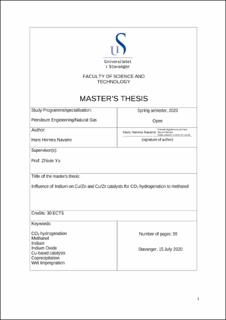| dc.description.abstract | The consequences of the anthropogenic carbon dioxide (CO2) released into the atmosphere have been forecasted as devastating for the global environment. It is mandatory to take action now, and there are alternatives under development to mitigate and counteract the aftermath of climate change. One possible major contributor is carbon capture, utilization, and storage (CCUS), and several of its technologies have been successfully tested, such as the use of CO2 as feedstock for different chemical processes. Converting emissions into methanol (CH3OH) represents an interesting alternative for contributing to this solution. The conversion of CO2 into valuable products is a technology with almost 100 years of history, although it has yet to reach optimal processing and maturity.
CO2 hydrogenation to methanol is a process that requires moderate temperature and pressure to be effective. The catalysts used for converting CO2 into methanol at a limited number of CO2-to-methanol plants are based on a mix of metallic copper (Cu), zinc oxide (ZnO), and aluminum oxide (Al2O3). However, more efficient catalysts are necessary for large-scale implementation as the current catalyst is easily deactivated. Among many promoters tested to improve the catalyst’s performance, zirconium oxide (ZrO2) is considered an excellent promoter for Cu-based catalysts. Moreover, indium oxide (In2O3) has been investigated as a promising base catalyst due to its high methanol selectivity and good performance in hightemperature applications.
In this work, a set of Cu-based catalysts were synthesized using ZnO, ZrO2, and In2O3 as promoters. The catalysts were prepared by coprecipitation or wet impregnation. Synthesized catalysts were characterized by N2 physisorption, X-ray diffraction (XRD), N2O titration, H2temperature programmed reduction, and inductively coupled plasma optical emission spectroscopy (ICP-OES).
The activity tests were performed in a packed bed reactor (PBR) at 230 ⁰C, 30 bars, and a feed stream of H2/CO2/N2 with molar ratio 3:1:1. In2O3 improved the crystallite size of Copper particles and had a positive effect on the catalyst pore size, although has little impact in the catalytic activity of CO2 hydrogenation to methanol. CuZr-based catalysts showed better performance in terms of methanol selectivity (ca. 52%) vs. CO2 conversion (ca. 8%), however, CuZn catalysts are more active in terms of activity per area unit. Further investigations are required to achieve optimal ratios between Cu, Zn, Zr, and In2O3 for applications in industrial processes. | en_US |
